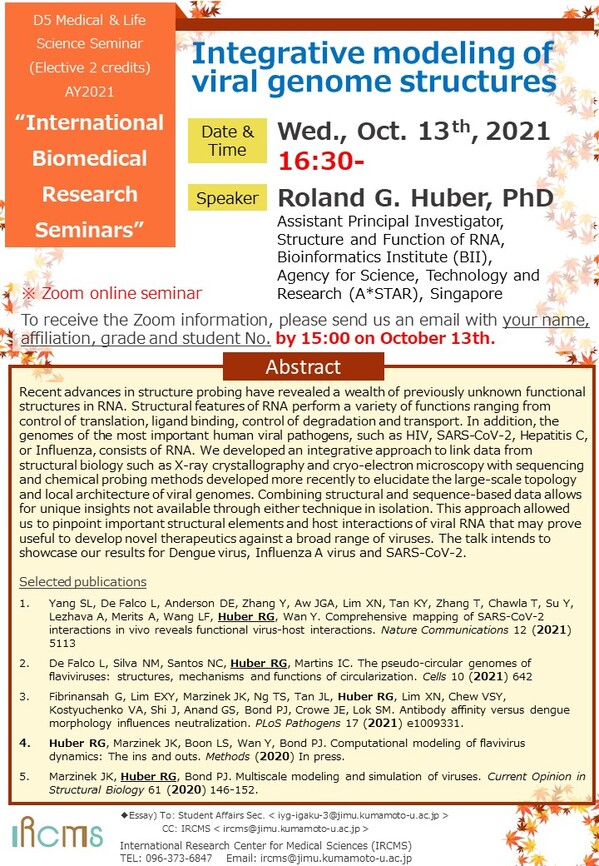- HOME
- News & Events
- [Oct. 13] D5 Medical & Life Science Seminar-Dr. Roland G. Huber
News & Events
[Oct. 13] D5 Medical & Life Science Seminar-Dr. Roland G. Huber
September 30 2021
The "D5 Medical & Life Science Seminar" course will be offered by International Research Center for Medical Sciences (IRCMS). It will run from April 2021 to March 2022, with lectures given by scientists who are affiliated with IRCMS or in collaboration with researchers at IRCMS. The lectures will be given once a month, in English, and by leading scientists in the relevant research field. Students will be taught: 1) how normal physiological functions are maintained in the human body; 2) how these systems become abnormal under certain pathophysiologic conditions; 3) why stem cells are important in animal development and homeostasis; 4) how stem cell-based approaches can help us understand disease mechanisms and find potential cure for diseases related to stem cell malfunction (e.g., cancer, aging).
Date : October 13, 2021 (Wednesday)
Time : 16:30 -
* Zoom online seminar
|
To receive the meeting ID / Password, please send an email to |
Speaker : Roland G. Huber, PhD
Assistant Principal Investigator,
Structure and Function of RNA,
Bioinformatics Institute (BII),
Agency for Science, Technology and Research (A*STAR), Singapore
Title : Integrative modeling of viral genome structures
Abstract :
Recent advances in structure probing have revealed a wealth of previously unknown functional structures in RNA. Structural features of RNA perform a variety of functions ranging from control of translation, ligand binding, control of degradation and transport. In addition, the genomes of the most important human viral pathogens, such as HIV, SARS-CoV-2, Hepatitis C, or Influenza, consists of RNA. We developed an integrative approach to link data from structural biology such as X-ray crystallography and cryo-electron microscopy with sequencing and chemical probing methods developed more recently to elucidate the large-scale topology and local architecture of viral genomes. Combining structural and sequence-based data allows for unique insights not available through either technique in isolation. This approach allowed us to pinpoint important structural elements and host interactions of viral RNA that may prove useful to develop novel therapeutics against a broad range of viruses. The talk intends to showcase our results for Dengue virus, Influenza A virus and SARS-CoV-2.
Selected publications:
- Yang SL, De Falco L, Anderson DE, Zhang Y, Aw JGA, Lim XN, Tan KY, Zhang T, Chawla T, Su Y, Lezhava A, Merits A, Wang LF, Huber RG, Wan Y. Comprehensive mapping of SARS-CoV-2 interactions in vivo reveals functional virus-host interactions. Nature Communications 12 (2021) 5113
- De Falco L, Silva NM, Santos NC, Huber RG, Martins IC. The pseudo-circular genomes of flaviviruses: structures, mechanisms and functions of circularization. Cells 10 (2021) 642
- Fibrinansah G, Lim EXY, Marzinek JK, Ng TS, Tan JL, Huber RG, Lim XN, Chew VSY, Kostyuchenko VA, Shi J, Anand GS, Bond PJ, Crowe JE, Lok SM. Antibody affinity versus dengue morphology influences neutralization. PLoS Pathogens 17 (2021) e1009331. IF: 6.218
- Huber RG, Marzinek JK, Boon LS, Wan Y, Bond PJ. Computational modeling of flavivirus dynamics: The ins and outs. Methods (2020) In press. IF: 3.782
- Marzinek JK, Huber RG, Bond PJ. Multiscale modeling and simulation of viruses. Current Opinion in Structural Biology 61 (2020) 146-152. IF: 7.179
Flyer: (Click for a larger image)

